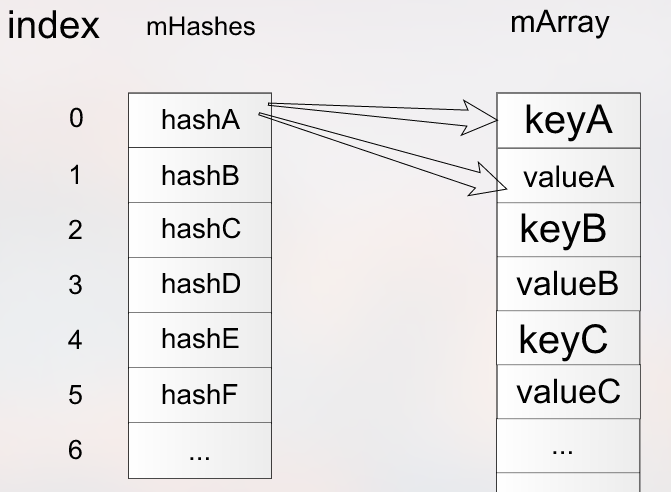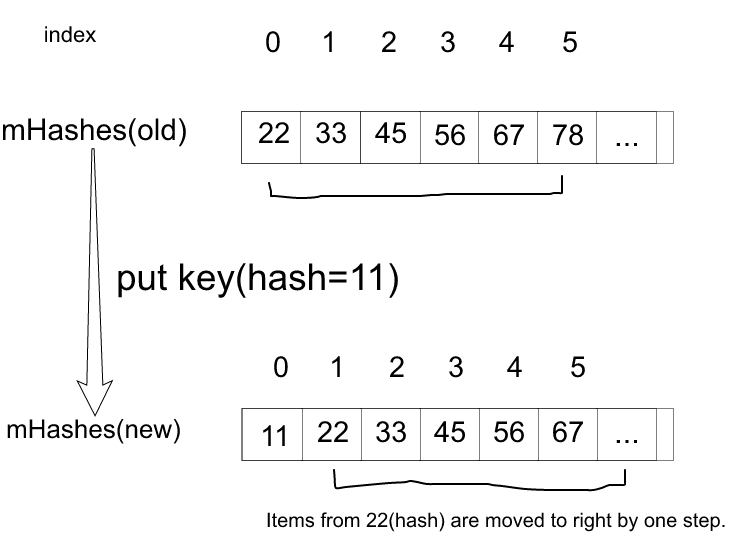深入剖析 Android中的 ArrayMap
数据集合在任何一门编程语言中都是很重要的一部分,在 Android 开发中,我们会实用到ArrayList, LinkedList, HashMap等。其中HashMap是用来处理键值对需求的常用集合。 而Android中引入了一个新的集合,叫做ArrayMap,为键值对存储需求增加了一种选择。
ArrayMap是什么
- 一个通用的key-value映射数据结构
- 相比HashMap会占用更少的内存空间
- android.util和android.support.v4.util都包含对应的ArrayMap类
ArrayMap的内部结构

如上图所示,在ArrayMap内部有两个比较重要的数组,一个是mHashes,另一个是mArray。
- mHashes用来存放key的hashcode值
- mArray用来存储key与value的值,它是一个Object数组。
其中这两个数组的索引对应关系是
mHashes[index] = hash; mArray[index<<1] = key; //等同于 mArray[index * 2] = key; mArray[(index<<1)+1] = value; //等同于 mArray[index * 2 + 1] = value;
注:向左移一位的效率要比 乘以2倍 高一些。
查找数据
查找数据是容器常用的操作,在Map中,通常是根据key找到对应的value的值。
ArrayMap中的查找分为如下两步
- 根据key的hashcode找到在mHashes数组中的索引值
- 根据上一步的索引值去查找key所对应的value值
其中占据时间复杂度最多的属于第一步:确定key的hashCode在mHahses中的索引值。
而这一步对mHashes查找使用的是二分查找,即Binary Search。所以ArrayMap的查询时间复杂度为 O(log n)
确定key的hashcode在mHashes中的索引的代码的逻辑
int indexOf(Object key, int hash) {
final int N = mSize;
//快速判断是ArrayMap是否为空,如果符合情况快速跳出
if (N == 0) {
return ~0;
}
//二分查找确定索引值
int index = ContainerHelpers.binarySearch(mHashes, N, hash);
// 如果未找到,返回一个index值,可能为后续可能的插入数据使用。
if (index < 0) {
return index;
}
// 如果确定不仅hashcode相同,也是同一个key,返回找到的索引值。
if (key.equals(mArray[index<<1])) {
return index;
}
// 如果key的hashcode相同,但不是同一对象,从索引之后再次找
int end;
for (end = index + 1; end < N && mHashes[end] == hash; end++) {
if (key.equals(mArray[end << 1])) return end;
}
// 如果key的hashcode相同,但不是同一对象,从索引之前再次找
for (int i = index - 1; i >= 0 && mHashes[i] == hash; i--) {
if (key.equals(mArray[i << 1])) return i;
}
//返回负值,既可以用来表示无法找到匹配的key,也可以用来为后续的插入数据所用。
// Key not found -- return negative value indicating where a
// new entry for this key should go. We use the end of the
// hash chain to reduce the number of array entries that will
// need to be copied when inserting.
return ~end;
}
既然对mHashes进行二分查找,则mHashes必须为有序数组。
插入数据
ArrayMap提供给我们进行插入数据的API有
- append(key,value)
- put(key,value)
- putAll(collection)
以put方法为例,需要注意的有
- 新数据位置确定
- key为null
- 数组扩容问题
新数据位置确定
为了确保mHashes能够进行二分查找,我们需要保证mHashes始终未有序数组。
在确定新数据位置过程中
- 根据key的hashcode在mHashes表中二分查找确定合适的位置。
- 如果新添加的数据的索引不是最后位置,在需要对这个索引之后的全部数据向后移动

key为null时
当key为null时,其实和其他正常的key差不多,只是对应的hashcode会默认成0来处理。
public V put(K key, V value) {
final int hash;
int index;
if (key == null) {
hash = 0;//如果key为null,其hashcode算作0
index = indexOfNull();
}
...
}
数组扩容问题
- 首先数组的容量会扩充到BASE_SIZE
- 如果BASE_SIZE无法容纳,则扩大到2 * BASE_SIZE
- 如果2 * BASE_SIZE仍然无法容纳,则每次扩容为当前容量的1.5倍。
具体的计算容量的代码为
/** * The minimum amount by which the capacity of a ArrayMap will increase. * This is tuned to be relatively space-efficient. */ private static final int BASE_SIZE = 4; final int n = mSize >= (BASE_SIZE*2) ? (mSize+(mSize>>1)) : (mSize >= BASE_SIZE ? (BASE_SIZE*2) : BASE_SIZE);
删除数据
删除ArrayMap中的一项数据,可以分为如下的情况
- 如果当前ArrayMap只有一项数据,则删除操作将mHashes,mArray置为空数组,mSize置为0.
- 如果当前ArrayMap容量过大(大于BASE_SIZE*2)并且持有的数据量过小(不足1/3)则降低ArrayMap容量,减少内存占用
- 如果不符合上面的情况,则从mHashes删除对应的值,将mArray中对应的索引置为null
ArrayMap的缓存优化
ArrayMap的容量发生变化,正如前面介绍的,有这两种情况
- put方法增加数据,扩大容量
- remove方法删除数据,减小容量
在这个过程中,会频繁出现多个容量为BASE_SIZE和2 * BASE_SIZE的int数组和Object数组。ArrayMap设计者为了避免创建不必要的对象,减少GC的压力。采用了类似对象池的优化设计。
这其中设计到几个元素
- BASE_SIZE 值为4,与ArrayMap容量有密切关系。
- mBaseCache 用来缓存容量为BASE_SIZE的int数组和Object数组
- mBaseCacheSize mBaseCache缓存的数量,避免无限缓存
- mTwiceBaseCache 用来缓存容量为 BASE_SIZE * 2的int数组和Object数组
- mTwiceBaseCacheSize mTwiceBaseCache缓存的数量,避免无限缓存
- CACHE_SIZE 值为10,用来控制mBaseCache与mTwiceBaseCache缓存的大小
这其中
- mBaseCache的第一个元素保存下一个mBaseCache,第二个元素保存mHashes数组
- mTwiceBaseCache和mBaseCache一样,只是对应的数组容量不同
具体的缓存数组逻辑的代码为
private static void freeArrays(final int[] hashes, final Object[] array, final int size) {
if (hashes.length == (BASE_SIZE*2)) {
synchronized (ArrayMap.class) {
if (mTwiceBaseCacheSize < CACHE_SIZE) {
array[0] = mTwiceBaseCache;
array[1] = hashes;
for (int i=(size<<1)-1; i>=2; i--) {
array[i] = null;
}
mTwiceBaseCache = array;
mTwiceBaseCacheSize++;
if (DEBUG) Log.d(TAG, "Storing 2x cache " + array
+ " now have " + mTwiceBaseCacheSize + " entries");
}
}
} else if (hashes.length == BASE_SIZE) {
synchronized (ArrayMap.class) {
if (mBaseCacheSize < CACHE_SIZE) {
array[0] = mBaseCache;
array[1] = hashes;
for (int i=(size<<1)-1; i>=2; i--) {
array[i] = null;
}
mBaseCache = array;
mBaseCacheSize++;
if (DEBUG) Log.d(TAG, "Storing 1x cache " + array
+ " now have " + mBaseCacheSize + " entries");
}
}
}
}
具体的利用缓存数组的代码为
private void allocArrays(final int size) {
if (mHashes == EMPTY_IMMUTABLE_INTS) {
throw new UnsupportedOperationException("ArrayMap is immutable");
}
if (size == (BASE_SIZE*2)) {
synchronized (ArrayMap.class) {
if (mTwiceBaseCache != null) {
final Object[] array = mTwiceBaseCache;
mArray = array;
mTwiceBaseCache = (Object[])array[0];
mHashes = (int[])array[1];
array[0] = array[1] = null;
mTwiceBaseCacheSize--;
if (DEBUG) Log.d(TAG, "Retrieving 2x cache " + mHashes
+ " now have " + mTwiceBaseCacheSize + " entries");
return;
}
}
} else if (size == BASE_SIZE) {
synchronized (ArrayMap.class) {
if (mBaseCache != null) {
final Object[] array = mBaseCache;
mArray = array;
mBaseCache = (Object[])array[0];
mHashes = (int[])array[1];
array[0] = array[1] = null;
mBaseCacheSize--;
if (DEBUG) Log.d(TAG, "Retrieving 1x cache " + mHashes
+ " now have " + mBaseCacheSize + " entries");
return;
}
}
}
mHashes = new int[size];
mArray = new Object[size<<1];
}
在Android中的应用
在Android Performance Pattern中,官方给出的使用场景为
1.item数量小于1000,尤其是插入数据和删除数据不频繁的情况。
2.Map中包含子Map对象
通过本文的介绍,我们对于ArrayMap应该有了一个比较深入的了解。虽然ArrayMap是Android系统中HashMap的一种替代,但是我们在使用时也要注意选择适宜的场景,切莫一概而论。
嗨,我是小广告:欢迎参加我的知乎Live 《我学安卓的那些套路》











![[HBLOG]公众号](https://www.liuhaihua.cn/img/qrcode_gzh.jpg)

